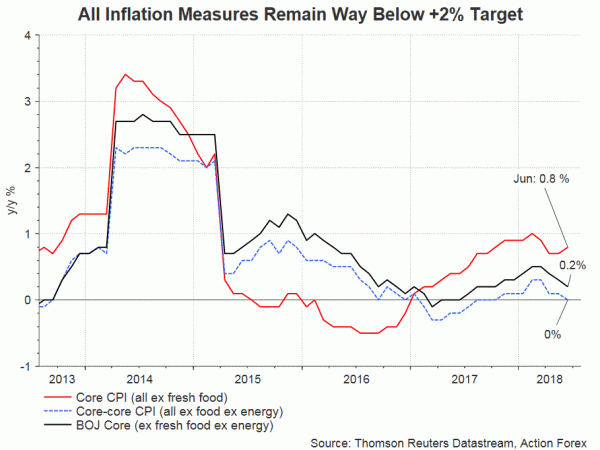BOJ made some changes in its unconventional monetary policy in July. We believe these changes sent a dovish message that it takes longer time than previous anticipated for inflation to reach the +2% target. At this meeting, BOJ introduced forward guidance reinforcing the commitment to keep for policy rate low so as to achieve the inflation target. Meanwhile, the Committee voted 7-2 to the guidelines for the yield curve control (YCC) program, compared with 8-1 at the previous meeting. In our opinion, the changes in the YCC program are subtle.
At the press conference Governor Kuroda admitted that it is “taking longer than expected for inflation to pick up” and achievement of the target will “be beyond our (three-year) forecast timeframe”. BOJ introduced forward guidance to the monetary policy outlook. As noted in the accompanying statement, the central bank “intends to maintain the current extremely low levels of short- and long-term interest rates for an extended period of time, taking into account uncertainties regarding economic activity and prices including the effects of the consumption tax hike scheduled to take place in October 2019”. Kuroda indicated that the forward guidance aims at strengthening the commitment to achieve the +2% inflation target. Moreover, it “intends to allow yields to move in double the range of +0.1% and – 0.1%”. Kuroda added that the Committee does not intend this change “to lead to a rise in interest rate levels”.
On the YCC program, the guideline for short-term interest rates stayed unchanged. Concerning long-term rates, BOJ pledged to JGBs so that 10-year JGB yields will remain at around 0%. The central bank added that “while doing so, the yields may move upward and downward to some extent mainly depending on developments in economic activity and prices”. Concerning the amount of JGBs to be purchased, BOJ would adopt “a flexible manner so that their amount outstanding will increase at an annual pace of about 80 trillion yen”. Fluctuations of yields and flexibility of JGBs purchases were not mentioned at the previous meeting. Same as before, BOJ would buy ETFs and J-REIT, so that their amounts outstanding will increase at annual paces of about 6 trillion yen and about 90 billion yen, respectively. Yet, BOJ added that it “may increase or decrease the amount of purchases depending on market conditions”, with “a view to lowering risk premia of asset prices in an appropriate manner”.
Furthermore, BOJ also announced to change the size of the policy-rate balance and the amount of each ETF to be purchased. For the former, BOJ suggested that it would “reduce the size of the Policy-Rate Balance in financial institutions’ current account balances at the Bank — to which a negative interest rate is applied — from the current level of about 10 trillion yen on average. This Balance is calculated assuming that arbitrage transactions take place in full among financial institutions”. For the latter, BOJ would “revise the purchase amount of each ETF and increase that of ETFs which track the Tokyo Stock Price Index (TOPIX)”.


 Signal2forex.com - Best Forex robots and signals
Signal2forex.com - Best Forex robots and signals




